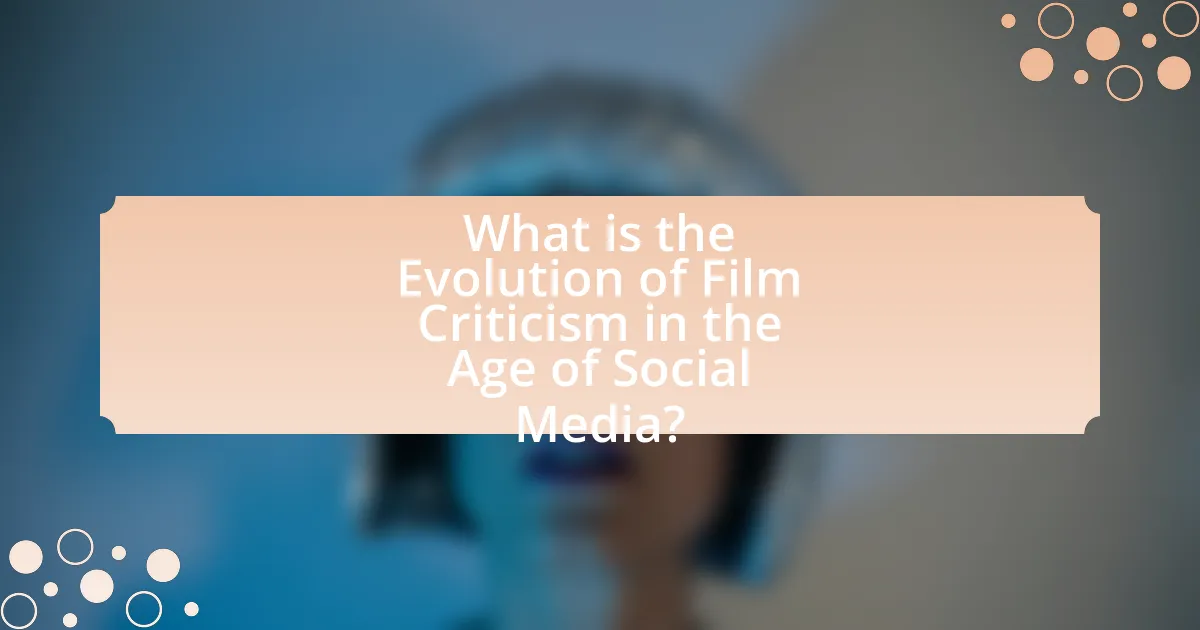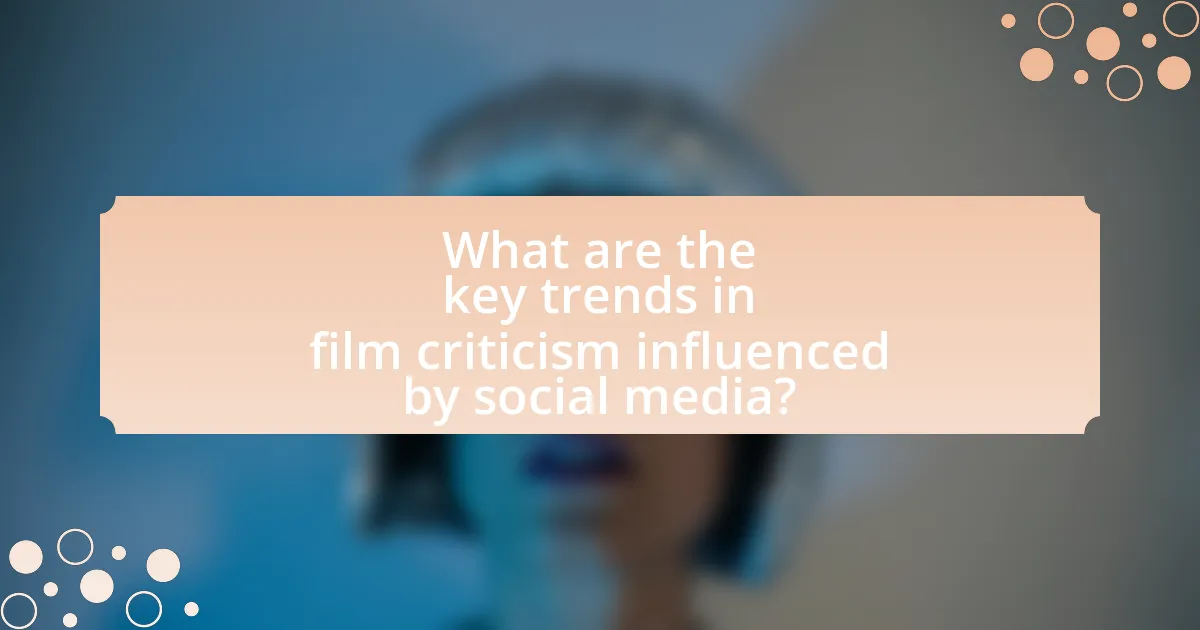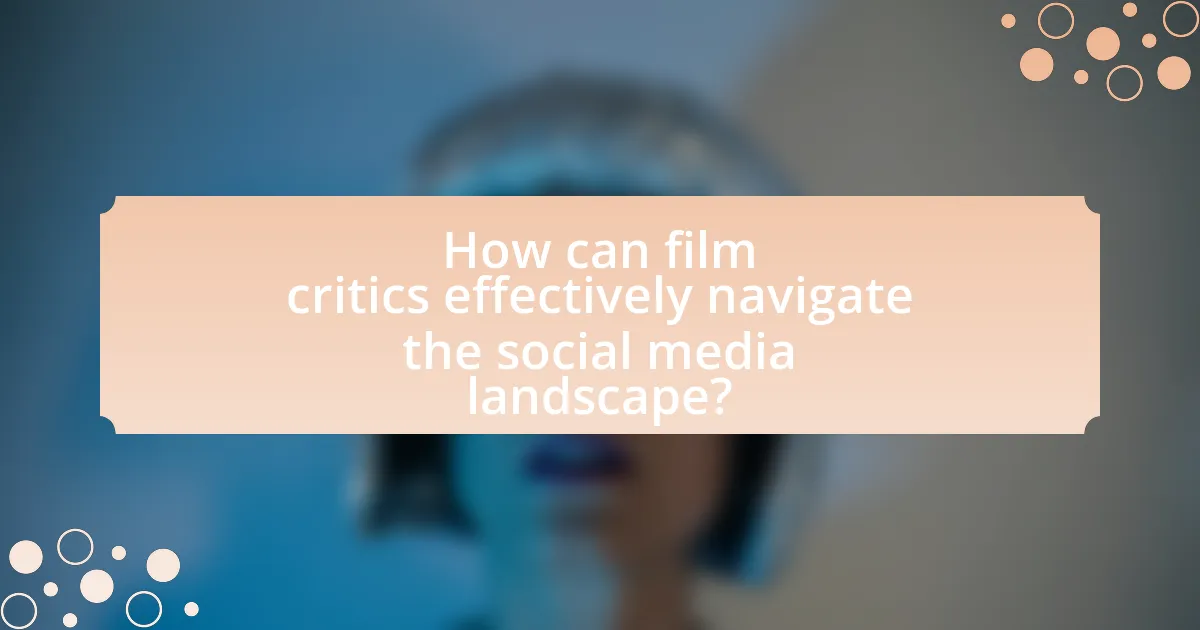The article examines the evolution of film criticism in the age of social media, highlighting the shift from traditional expert-driven reviews to a more democratized platform where diverse voices can express opinions. It discusses how social media platforms like Twitter, Instagram, and YouTube facilitate real-time audience engagement, influencing public perception and box office performance. Key differences between traditional and social media film criticism are outlined, including the immediacy and informality of user-generated content. The article also addresses the challenges faced by traditional critics, the impact of influencers, and the ethical considerations necessary for maintaining credibility in this rapidly changing landscape.

What is the Evolution of Film Criticism in the Age of Social Media?
The evolution of film criticism in the age of social media has transformed the landscape from traditional, expert-driven reviews to a more democratized platform where diverse voices can share opinions. Social media platforms like Twitter, Instagram, and YouTube have enabled audiences to engage with films in real-time, allowing for immediate reactions and discussions that were previously limited to professional critics. This shift has resulted in a broader range of perspectives, as user-generated content and influencer reviews often gain significant traction, sometimes overshadowing established critics. According to a 2021 study by the Pew Research Center, 72% of adults in the U.S. reported using social media to discuss films, highlighting the impact of these platforms on public discourse surrounding cinema.
How has social media transformed traditional film criticism?
Social media has transformed traditional film criticism by democratizing the platform for reviews and enabling real-time audience engagement. This shift allows anyone with internet access to share their opinions, leading to a diverse range of voices that challenge established critics. For instance, platforms like Twitter and Instagram facilitate immediate reactions to films, often influencing public perception and box office performance. According to a 2021 study by the Pew Research Center, 69% of adults in the U.S. use social media, which highlights the significant reach and impact these platforms have on film discourse. Consequently, traditional critics now often consider social media trends and audience reactions in their analyses, reflecting a more collaborative and interactive landscape in film criticism.
What are the key differences between traditional and social media film criticism?
Traditional film criticism is typically characterized by formal reviews published in print or established online platforms, while social media film criticism is informal, immediate, and often user-generated content shared across platforms like Twitter, Instagram, and TikTok. Traditional critics usually have formal training and adhere to established standards of critique, focusing on in-depth analysis, historical context, and artistic merit. In contrast, social media critics often prioritize personal opinions, brevity, and engagement, leading to a more diverse range of voices but less structured analysis. The immediacy of social media allows for real-time reactions and discussions, whereas traditional criticism often involves a delayed publication process, resulting in a more polished but less spontaneous critique.
How do social media platforms influence the way films are critiqued?
Social media platforms significantly influence film critique by democratizing the review process and amplifying diverse voices. These platforms allow users to share immediate reactions and opinions, which can shape public perception and influence traditional critics. For instance, the rise of platforms like Twitter and Instagram has led to the phenomenon of “Twitter reviews,” where audiences express their thoughts in real-time, often before professional critics publish their reviews. This shift has been evidenced by the increased visibility of user-generated content, with studies showing that audience ratings on platforms like Rotten Tomatoes can impact box office performance. Additionally, social media facilitates the rapid spread of both positive and negative critiques, creating a more dynamic and interactive environment for film discussion.
Why is the evolution of film criticism important in today’s digital landscape?
The evolution of film criticism is important in today’s digital landscape because it reflects the shift in how audiences consume and engage with media. Traditional film criticism, once dominated by print publications and established critics, has transformed with the rise of social media platforms, allowing diverse voices and perspectives to emerge. This democratization of criticism enables real-time feedback and interaction between filmmakers and audiences, fostering a more inclusive dialogue about films. According to a 2021 study by the Pew Research Center, 72% of adults in the U.S. use social media, highlighting its role in shaping public opinion and discourse around films. This evolution not only influences viewer choices but also impacts the film industry by encouraging filmmakers to consider audience reactions and critiques in their work.
What role does audience engagement play in modern film criticism?
Audience engagement significantly influences modern film criticism by shaping opinions and driving discussions. In the age of social media, platforms like Twitter and Instagram allow audiences to share their reactions instantly, creating a dialogue that can impact critical reception. For instance, films that generate buzz through audience engagement often see a correlation with box office success, as evidenced by the phenomenon of “viral” films that gain traction through user-generated content and reviews. This shift has led critics to consider audience sentiment as a vital component of their analyses, reflecting a more democratic approach to film evaluation.
How has the accessibility of film criticism changed with social media?
The accessibility of film criticism has significantly increased due to social media platforms. Social media allows anyone with internet access to share their opinions and reviews, democratizing film criticism beyond traditional gatekeepers like newspapers and magazines. For instance, platforms such as Twitter, Instagram, and YouTube enable users to post reviews instantly, reaching a global audience and fostering diverse perspectives. According to a 2021 study by the Pew Research Center, 72% of adults in the U.S. use social media, which has contributed to a surge in user-generated content related to film, making it easier for audiences to engage with and access varied critiques.

What are the key trends in film criticism influenced by social media?
Key trends in film criticism influenced by social media include the rise of user-generated content, the immediacy of reviews, and the impact of influencer culture. User-generated content has democratized film criticism, allowing audiences to share their opinions on platforms like Twitter and Instagram, which often leads to a broader range of perspectives. The immediacy of social media enables critics and audiences to share reviews and reactions in real-time, significantly affecting box office performance and public perception. Additionally, influencer culture has shifted the landscape, as social media influencers often have substantial followings and can sway opinions more than traditional critics, highlighting the importance of audience engagement in shaping film narratives. These trends reflect a significant transformation in how films are discussed and critiqued in the digital age.
How do influencers and critics on social media shape public opinion about films?
Influencers and critics on social media significantly shape public opinion about films by leveraging their platforms to disseminate reviews, opinions, and recommendations that reach vast audiences. Their ability to create engaging content, such as video reviews or social media posts, allows them to influence viewer perceptions and expectations before a film’s release. For instance, a study by the Pew Research Center found that 70% of social media users rely on these platforms for film recommendations, highlighting the impact of influencers and critics on audience choices. Additionally, the immediacy of social media enables real-time feedback and discussions, further amplifying their influence as audiences engage with and share opinions, thus shaping collective sentiment around films.
What impact do film review aggregators have on social media discussions?
Film review aggregators significantly influence social media discussions by shaping public perception and engagement with films. These platforms, such as Rotten Tomatoes and Metacritic, provide aggregated scores that serve as a quick reference for audiences, often leading to heightened discussions on social media about the quality and reception of films. Research indicates that films with higher aggregate scores tend to generate more positive conversations and increased sharing on platforms like Twitter and Facebook. For instance, a study by the University of Southern California found that a 10% increase in a film’s Rotten Tomatoes score correlates with a 20% increase in social media mentions. This demonstrates that film review aggregators not only impact individual opinions but also drive collective discourse, influencing audience behavior and expectations.
How do viral trends affect the reception of films?
Viral trends significantly influence the reception of films by amplifying audience awareness and engagement. When a film becomes part of a viral trend, it often garners increased attention on social media platforms, leading to heightened discussions and shares among users. For instance, films like “Bird Box” and “The Irishman” experienced substantial boosts in viewership and critical discourse due to viral challenges and memes associated with them. This phenomenon is supported by data showing that films trending on platforms like Twitter or TikTok can see a marked increase in box office revenue and streaming numbers, as audiences are more likely to watch films that are actively being discussed and recommended by their peers.
What challenges do traditional film critics face in the age of social media?
Traditional film critics face significant challenges in the age of social media, primarily due to the rapid dissemination of information and the rise of user-generated content. The immediacy of social media platforms allows audiences to share opinions and reviews instantly, often overshadowing traditional critiques that require more time for analysis. Additionally, the influence of social media algorithms can prioritize popular opinions over expert insights, leading to a dilution of critical discourse. According to a study by the Pew Research Center, 72% of adults in the U.S. get news from social media, indicating that traditional critics must compete with a vast array of voices, many of which lack formal training or expertise. This shift has resulted in traditional critics struggling to maintain relevance and authority in a landscape increasingly dominated by informal reviews and viral content.
How do traditional critics adapt to the fast-paced nature of social media?
Traditional critics adapt to the fast-paced nature of social media by embracing digital platforms for immediate engagement and feedback. They utilize social media to share concise reviews, participate in trending discussions, and connect with audiences in real-time, which contrasts with the slower, more formal publication processes of traditional media. For instance, critics often post quick reactions on Twitter or Instagram, allowing them to remain relevant and visible in a rapidly changing landscape where audiences expect instant commentary. This shift not only broadens their reach but also encourages a more interactive dialogue with viewers, enhancing their influence in the film criticism community.
What are the risks of misinformation in film criticism on social media?
Misinformation in film criticism on social media poses significant risks, including the distortion of public perception and the potential to misguide audience expectations. When critics share inaccurate information or biased opinions, it can lead to widespread misconceptions about a film’s quality, themes, or messages. For instance, a study by the Pew Research Center found that 64% of Americans believe that misinformation has caused confusion about basic facts, which can directly impact how films are received and discussed. Additionally, misinformation can undermine the credibility of legitimate critics, making it harder for audiences to discern trustworthy reviews from misleading ones. This erosion of trust can ultimately affect box office performance and the overall cultural discourse surrounding cinema.

How can film critics effectively navigate the social media landscape?
Film critics can effectively navigate the social media landscape by actively engaging with audiences, utilizing analytics to understand viewer preferences, and maintaining a consistent online presence. Engaging with audiences through comments, discussions, and social media platforms fosters community and builds rapport, which is essential in the digital age where audience interaction is paramount. Utilizing analytics tools, such as Google Analytics or social media insights, allows critics to track engagement metrics and tailor their content to meet audience interests, enhancing relevance and reach. Maintaining a consistent online presence across multiple platforms, including Twitter, Instagram, and YouTube, ensures that critics remain visible and relevant in a fast-paced environment where content is constantly being produced and consumed.
What strategies can critics use to engage audiences on social media?
Critics can engage audiences on social media by utilizing interactive content, such as polls and Q&A sessions, to foster direct communication. This strategy encourages audience participation and creates a sense of community around the critique. For instance, a study by the Pew Research Center found that 72% of adults use social media, indicating a vast potential audience for critics to connect with. Additionally, sharing multimedia content, like video reviews or behind-the-scenes footage, can enhance engagement by appealing to visual learners and creating a more dynamic experience. This approach aligns with the trend of increased video consumption on platforms like Instagram and TikTok, where short, engaging clips can capture attention quickly.
How can critics balance personal opinions with professional integrity?
Critics can balance personal opinions with professional integrity by adhering to established ethical guidelines and maintaining transparency in their reviews. Ethical guidelines, such as those from the Society of Professional Journalists, emphasize accuracy, fairness, and accountability, which help critics navigate their subjective views while providing objective assessments. Transparency involves disclosing any potential conflicts of interest, such as personal relationships with filmmakers or financial ties, which fosters trust with the audience. By prioritizing these principles, critics can ensure their personal biases do not compromise their professional responsibilities, ultimately enhancing the credibility of their critiques in the evolving landscape of film criticism influenced by social media.
What tools can critics utilize to enhance their social media presence?
Critics can utilize tools such as social media management platforms, analytics tools, and content creation software to enhance their social media presence. Social media management platforms like Hootsuite and Buffer allow critics to schedule posts, engage with audiences, and manage multiple accounts efficiently. Analytics tools such as Google Analytics and Sprout Social provide insights into audience behavior and engagement metrics, enabling critics to tailor their content effectively. Content creation software like Canva and Adobe Spark helps critics design visually appealing graphics and videos, which can increase engagement and shareability on social media. These tools collectively empower critics to optimize their online presence and reach a broader audience.
What best practices should film critics follow in the age of social media?
Film critics should prioritize transparency, engagement, and accuracy in the age of social media. Transparency involves disclosing any potential conflicts of interest, such as sponsorships or affiliations with studios, to maintain credibility. Engagement with audiences through comments and discussions fosters community and allows critics to understand diverse perspectives, enhancing their reviews. Accuracy is crucial; critics must fact-check information and avoid spreading misinformation, as social media can amplify inaccuracies rapidly. For instance, a study by the Pew Research Center found that 64% of Americans believe that social media has a significant impact on public opinion, highlighting the responsibility critics have in shaping informed discourse.
How can critics maintain credibility while leveraging social media platforms?
Critics can maintain credibility while leveraging social media platforms by adhering to ethical standards, providing well-researched content, and engaging transparently with their audience. Ethical standards, such as disclosing any potential conflicts of interest and avoiding sensationalism, help build trust. Research indicates that critics who consistently provide in-depth analysis and context for their opinions are perceived as more credible; for example, a study by the Pew Research Center found that audiences value expertise and thoroughness in reviews. Additionally, engaging transparently with followers by responding to comments and acknowledging differing opinions fosters a sense of community and respect, further enhancing credibility.
What are the ethical considerations for film critics on social media?
Film critics on social media must navigate several ethical considerations, including transparency, accountability, and the potential for bias. Transparency involves clearly disclosing any conflicts of interest, such as financial ties to studios or promotional partnerships, which can influence their reviews. Accountability requires critics to stand by their opinions and be open to public scrutiny, as their reviews can significantly impact a film’s success. Additionally, critics must be aware of their own biases and strive for objectivity, as personal preferences can skew their assessments. These ethical standards are essential for maintaining credibility and trust within the film community and among audiences.